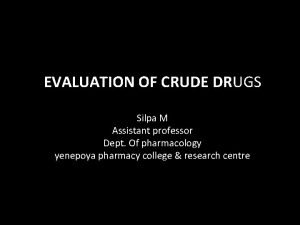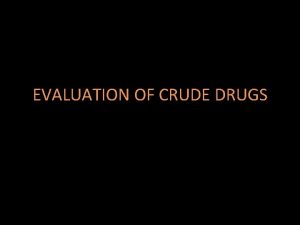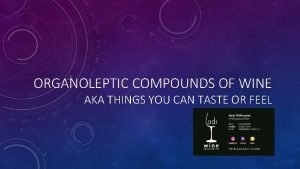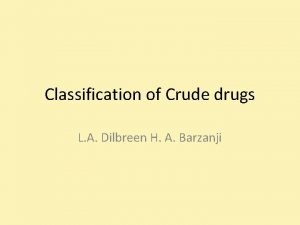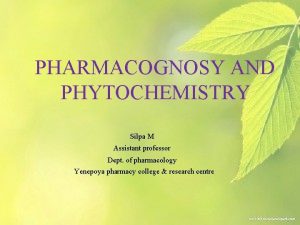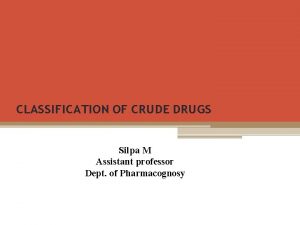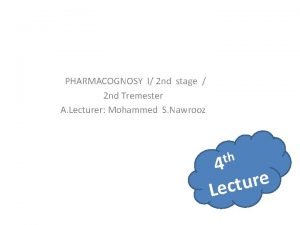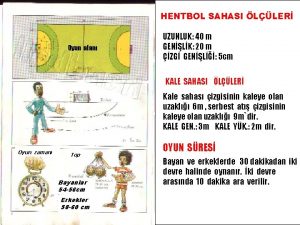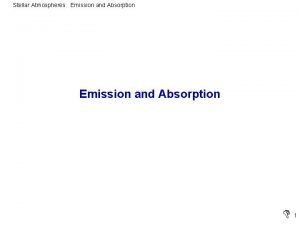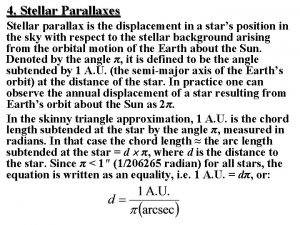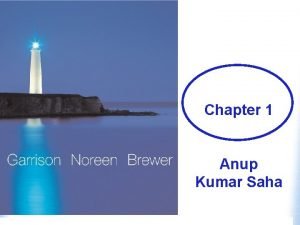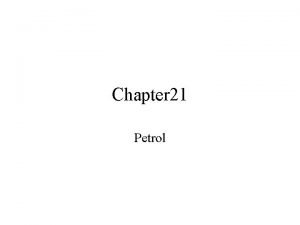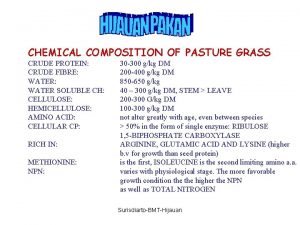Organoleptic Evaluation of Crude Drugs Dr Amit Saha



















- Slides: 19

Organoleptic Evaluation of Crude Drugs Dr. Amit Saha Assistant Prof. in Botany(Stage III) Surendranath College, Kolkata

• Evaluation of drugs deals with the correct identification of the plant and determination of quality and purity of the crude drugs. • The high quality of the drug is maintained by collection of the drug from the correct natural source at proper time, preparation of samples of the collected drugs by proper cleaning, drying and proper preservation. • The evaluation is done by studying its organoleptic, microscopic, biological, chemical and physical properties.




Crude Drugs


Organoleptic Evaluation • It means the study of a drug with the help of organs of sense which includes its external morphology, colour, taste, sound of its fracture. • Morphological characters- to study morphology of a drug, its shape, size, colour, external markings, fracture, internal colour, odour and taste are examined.


The organized drugs are classified into • Barks- Cinnamon, Cinchona • Underground structures- Ginger, Dioscorea, Liquorice. • Leaves- Tulsi, Vasaka, Digitalis • Flowers- Saffron • Fruits- Cardamom, Almond, Amla • Seeds- Linseed, Nux-vomica • Herbs-Brahmi, Kalmegh

Shape of the drug • Cylindrical(Sarsaparilla) • Subcylindrical(Podophyllum) • Conical(Aconite) • Fusiform, ovoid or pyriform(Jalap) • Terete or disk shaped(Nux vomica) • The drug may be simple, branched, curved or twisted. The length, breadth and diameter are measured in mm or cm



External markings Furrows, Ridges Wrinkles Annulations Fissures Nodules Projections Scars of leaf, stem base, root, bud scale Fractures may be complete, incomplete, short, fibrous, splintery(breaking irregularly), brittle, tough and weak. • Glycyrrhiza has hard and fibrous structure due to presence of fibrous and woody tissues. Aconite has a horny fracture due to geltainzation of starch. • •

Sensory characters(Colour, texture, odour and taste) • This method is esp. applicable to drugs containing volatile oils or pungent principles(e. g. Capsicum) • The external color varies from white to yellowish gey, brown, orange, or brownish black. The color of some drugs changes if they are dried in sunlight. • Colour of drugs are standardized and determined by the Inter-Society Colour Concil National Bureau of Standard Method. E. g. Reserpine is described as white or pale buff to slightly yellowish, odourless crystalline powder.

• The odour of a drug may either be distinct(Mentha, clove) or indistinct. • Terms used to define odour are aromatic, balsamic, spicy, alliaceous( garlic like), camphoraceous, terebinthinate (turpentine like) • Ergot has rancid( ammonical) smell.

• Taste is a particular sensation production by certain substances when these come into contact with taste buds present in epithelial layer of the mouth. • The taste may be sour(acidic), salty(saline), sweet(saccharine), bitter, alkaline and metallic. • Drugs like Ginger, Capsicum have pungent taste, Chiraita and Kalmegh have bitter taste, Glycyrrhiza and Honey are sweet in taste. • The taste produced by tongue are classified as mucilaginous, oily, astringent( contraction of the tissues if mouth), pungent(warm biting sensation), acrid(unpleasant, irritating sensation) and nauseous(causing vomiting).


References • Internet Archives • Wallis, T. E. - Text Book of Pharmacognosy. CBS Publishers & Distributors • Trease, G. E. & Evans, W. C. 1983, Pharmacognosy. Bailliere. Tindall, London. • Ali, M. 2010. Textbook of Pharmacognosy. Second Ed. CBS Publishers. • Studies in Botany Vol II by Guha, Mitra and Chaudhuri
 Lycopodium spore method for percentage purity
Lycopodium spore method for percentage purity Vein islet number definition
Vein islet number definition Organoleptic compounds
Organoleptic compounds Enemas are the liquid dosage forms used for
Enemas are the liquid dosage forms used for Define adulteration of crude drugs
Define adulteration of crude drugs Classification of crude drugs
Classification of crude drugs Difference between organized and unorganized drugs
Difference between organized and unorganized drugs Crude drugs classification
Crude drugs classification Alphabetical classification advantages and disadvantages
Alphabetical classification advantages and disadvantages Storage of crude drugs
Storage of crude drugs Hentbol oyun kuralları
Hentbol oyun kuralları Saha ionization equation
Saha ionization equation Suranjana saha
Suranjana saha Voleybol
Voleybol Saha equation
Saha equation Conto kalimah pananya cara nya éta
Conto kalimah pananya cara nya éta Eskrim saha ölçüleri
Eskrim saha ölçüleri Dr prantik saha
Dr prantik saha Saha gözlem ziyaretleri
Saha gözlem ziyaretleri Suranjana saha
Suranjana saha
